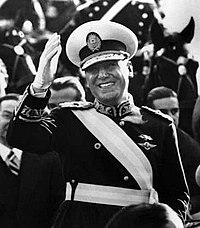First Dictatorship and Rise of Peron

President Perón at his 1946 inaugural parade.
If you turn to face the Avenue de Mayo you will see the dome of the parliament at the end of the Avenue. A great place to talk a little bit about the first dictatorship after the coup d’etat took over in 1930 without making you walk ten blocks there and back!
“We’ve already talked about the first coup d’etat in 1930.”
Where the army took advantage of a bad economic situation…
“…and they although they were very authoritarian, very religious, they were clever enough and tried to get out from the crisis as fast as possible. The only thing they had was this avenue, and Line A.”
The regime constructed all the rest of the major avenues in the city and all the rest of the subway lines. Believe it or not they complete all this in five years.
“Of course, it was easy for a dictatorship to expropriate, to do what they wanted. But they constructed the best infrastructure we still have today was done by these dictatorships.”
In Argentina’s early history the oligarchy – the ruling elite – were the power houses. But from the late 19th century on, you had an influx of middle-class immigrants to the country. After the first world war immigration started declining. In 1914 a census said half the population was foreign. The 1930’s was the rise of this lower-class factory worker. As Juan says, the regime…
“…they had a plan of replacing imports. So, it was a time in which Argentina started opening its first important factories. The workers that come from, especially from the north of Argentina, to work here and settle in the outskirts to work in the factories that open here. The first person to see that this new social class had to join political life, and he also could construct power from this new social class, was Peron. Peron started being more powerful in the 40s. But he, as a young colonel, he had been in Italy with Mussolini. And he got attracted by the way Mussolini fought communism with social reforms. Peron always said that he was a kind of third position because he was a big social reformer. But at the same time, he fought communism.”
Then in 1943 came the second coup d’etat against the dictator in power. By coup d’etat Juan means…
“I mean the parts of the army against other part of the army.”
The main political reason for the coup was because the dictator in 1943 wanted to join the Allies in the Second World War, and a group of officers revolted against him to keep neutrality.
“Peron was part of these officers that were for neutrality. They said it was not clever from Argentina to join the allies…. “
….because Argentina was exporting goods to both sides. They were getting rich by being neutral. When the coup d’etat was victorious the different officers started dividing up the ministries they wanted. Peron…
“He said, ‘I want Labour, the Labour Office.’ The Labour was very tiny, nobody cared about it so much. But he was more clever than the rest.
In less than two years he got very powerful. He decided to destroy what he called the threat of communism, meaning the current labour unions which had been founded by the Italian and Spanish immigrants.
“Italians, and Spanish had strong leftist ideas. The biggest union in the ’30s was anarchists. They were extreme. And they were getting powerful, and they were also educating these people from the provinces that didn’t know who Marx was at all.”
So Peron, as the minister of labour opened new unions.
“He only gave benefits to his union. So, all the workers moved to this Peronist unions.”
And the communist anarchist leaders went from being huge leaders to discussing Lenin, alone, in a café.
“He destroyed all the leftist movements. But then he went maybe too far, according to the government here…”
With a big part of the army seeing Peron as a threat as a Labour leader.
“And they sent him to jail in an island in the middle of the river-plates. So, in October 17th, 1945, for the first time in history masses came here and said, ‘We want Peron free.’
“Maybe there are people who always thought the European immigrants, and the landowners, who never thought that Argentina could be something more apart from white European people, were shocked. The Dictator felt so much pressure, he set Peron free. And Peron came out to that balcony and announced he would be a candidate for the elections.”
Discover more about Peron’s family, the charismatic Eva Peron, and the coup d’etat that violently ended his presidency after her death at the next location.
Next Location – Peron and the Second Coup D’etat: Walk through the centre of the square, towards the big pink building know as Casa Rosada and stop on the Plaza side of the road across from this Presidential Palace.